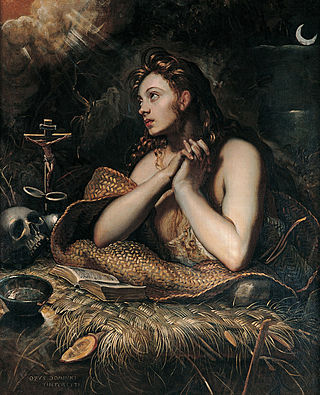
Mary Magdalene was a woman who, according to the four canonical gospels, traveled with Jesus as one of his followers and was a witness to His crucifixion and resurrection. She is mentioned by name twelve times in the canonical gospels, more than most of the apostles and more than any other woman in the gospels, other than Jesus's family. Mary's epithet Magdalene may be a toponymic surname, meaning that she came from the town of Magdala, a fishing town on the western shore of the Sea of Galilee in Roman Judea.

John 20:15 is the 15th verse of the twentieth chapter of the Gospel of John in the New Testament of the Christian Bible. Mary Magdalene has returned to Jesus' tomb and found it empty. She does not know that Jesus has risen from death and they begin conversing without her realizing his identity.
John 20 is the twentieth chapter of the Gospel of John in the New Testament. It relates the story of Jesus' resurrection. It relates how Mary Magdalene went to the tomb of Jesus and found it empty. Jesus appears to her and speaks of his resurrection and dispatches Mary to tell the news to the disciples. Jesus then appears to his disciples. The events related in John 20 are described somewhat differently in Matthew 28, Mark 16, and Luke 24.

John 20:12 is the twelfth verse of the twentieth chapter of the Gospel of John in the New Testament of the Christian Bible. Mary Magdalene is peering into the empty tomb of Jesus and sees two angels.
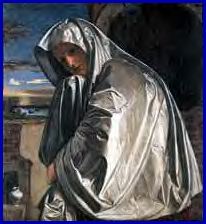
John 20:11 is the eleventh verse of the twentieth chapter of the Gospel of John in the New Testament of the Christian Bible.
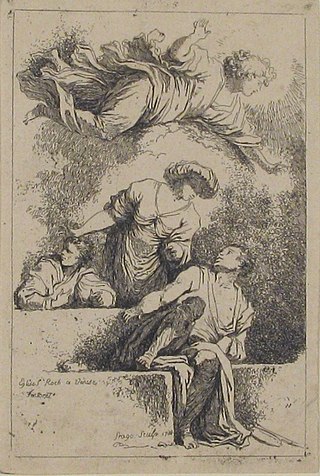
John 20:10 is the tenth verse of the twentieth chapter of the Gospel of John. Peter and the Beloved Disciple have just finished examining the empty tomb of Jesus, and in this verse they return home.

John 20:9 is the ninth verse of the twentieth chapter of the Gospel of John in the Bible. Peter and the Beloved Disciple have been examining Jesus' empty tomb and the arrangement of the grave clothes. John 20:8 states that the Beloved Disciple looked in the tomb and believed, though there is conflict on what exactly he believed. John 20:9 seems to modify this statement but its exact meaning is also unclear.

John 20:8 is the eighth verse of the twentieth chapter of the Gospel of John in the New Testament of the Christian Bible. Peter and the Beloved Disciple are examining Jesus's empty tomb. Peter has been inside the tomb since John 20:6, while the Beloved Disciple had been examining it from outside. In this verse the Beloved Disciple enters the tomb.
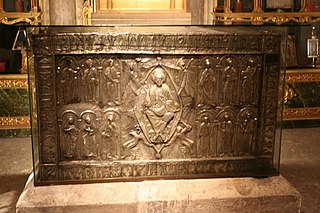
John 20:7 is the seventh verse of the twentieth chapter of the Gospel of John in the Bible. In this verse, Peter is standing in Jesus' empty tomb. The Beloved Disciple and perhaps Mary Magdalene are outside. This verse describes the arrangement of the grave clothes they see.

John 20:16 is the sixteenth verse in the twentieth chapter of the Gospel of John in the New Testament of the Bible. The verse describes the moment that Mary Magdalene realizes that Jesus has returned from the dead, when she recognizes his voice calling her name.

John 20:6 is the sixth verse of the twentieth chapter of the Gospel of John in the Bible. Peter and the Beloved Disciple have just arrived at the empty tomb of Jesus. The Beloved Disciple, who arrived slightly ahead of Peter, paused outside the empty tomb. In the verse, Peter enters the tomb upon his arrival.

John 20:5 is the fifth verse of the twentieth chapter of the Gospel of John in the Bible. The Beloved Disciple and Peter have travelled to the tomb of Jesus to investigate Mary Magdalene's report that the body of Jesus had disappeared. In this verse the Beloved Disciple arrives at the tomb and while he looks in, he does not enter it.

John 20:2 is the second verse of the twentieth chapter of the Gospel of John in the New Testament. Mary Magdalene has just discovered that the tomb of Jesus has been opened. In this verse she seeks out and tells this news to Peter and the "disciple whom Jesus loved".

John 20:3–4 are the third and fourth verses of the twentieth chapter of the Gospel of John in the New Testament. Peter and the Beloved Disciple have been informed by Mary Magdalene that Jesus' tomb has been opened and in these verses they depart for the tomb.

Luke 24 is the twenty-fourth and final chapter of the Gospel of Luke in the New Testament of the Christian Bible. The book containing this chapter is anonymous, but early Christian tradition uniformly affirmed that Luke the Evangelist composed this Gospel as well as the Acts of the Apostles. This chapter records the discovery of the resurrection of Jesus Christ, his appearances to his disciples and his ascension into heaven.
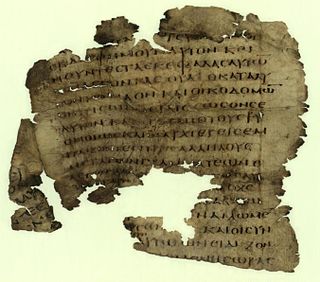
Mark 15 is the fifteenth chapter of the Gospel of Mark in the New Testament of the Christian Bible. This chapter records the narrative of Jesus' passion, including his trial before Pontius Pilate and then his crucifixion, death and entombment. Jesus' trial before Pilate and his crucifixion, death, and burial are also recorded in Matthew 27, Luke 23, and John 18:28–19:42.

Matthew 28:1 is the first verse of the twenty-eighth chapter of the Gospel of Matthew in the New Testament. This verse opens the resurrection narrative as Mary Magdalene and "the other Mary" visit Jesus' tomb after the crucifixion.

Matthew 27:61 is the sixty-first verse of the twenty-seventh chapter of the Gospel of Matthew in the New Testament. This verse describes two women waiting by the Tomb of Jesus after the crucifixion.

Matthew 27:55–56 are the fifty-sixth and fifty-seventh verses of the twenty-seventh chapter of the Gospel of Matthew in the New Testament. The crucifixion and death of Jesus have just occurred, and these verses make note of a group of women who were present at that event.

The Three Marys are women mentioned in the canonical gospels' narratives of the crucifixion and resurrection of Jesus. Mary was the most common name for Jewish women of the period.


















